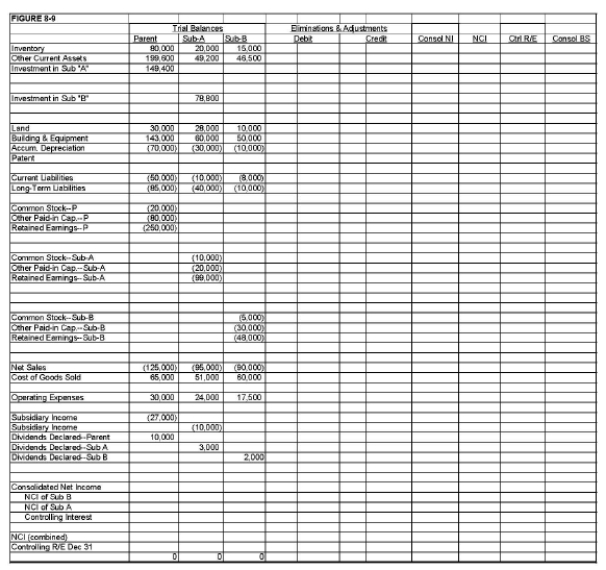Essay
On January 1, 20X1, Parent Company purchased 90% of the common stock of Sub-A Company for $90,000. On this date, Sub-A had common stock, other paid-in capital, and retained earnings of $10,000, $20,000, and $60,000 respectively.
On January 1, 20X2, Sub-A Company purchased 80% of the common stock of Sub-B Company for $64,000. On this date, Sub-B Company had common stock, other paid-in capital, and retained earnings of $5,000, $30,000, and $40,000 respectively.
Any excess of cost over book value on either purchase is due to a patent, to be amortized over ten years.
Both Parent and Sub-A have accounted for their investments using the simple equity method.
During 20X2, Sub-B sold merchandise to Sub-A for $20,000, of which one-fourth is still held by Sub-B on December 31, 20X2. Sub-B's usual gross profit is 40%. During 20X3, Sub-B sold more goods to Sub-A for $30,000, of which $10,000 is still on hand on December 31, 20X3.
Required:
Complete the Figure 8-9 worksheet for consolidated financial statements for 20X3. 
Correct Answer:

Verified
Determination and Distribution of Excess...View Answer
Unlock this answer now
Get Access to more Verified Answers free of charge
Correct Answer:
Verified
View Answer
Unlock this answer now
Get Access to more Verified Answers free of charge
Q8: Apple Inc. owns a 90% interest in
Q10: On January 1, 20X1, Parent Company purchased
Q11: Pepper Company owned 60,000 of Salt Company's
Q15: On January 1, 20X1, Parent Company purchased
Q17: Company P had 300,000 shares of common
Q17: On January 1, 20X1, Paul, Inc. acquired
Q18: When a parent purchases a portion of
Q22: When a subsidiary purchases shares of the
Q25: Company P owns 80% of the 10,000
Q41: When a parent purchases a portion of